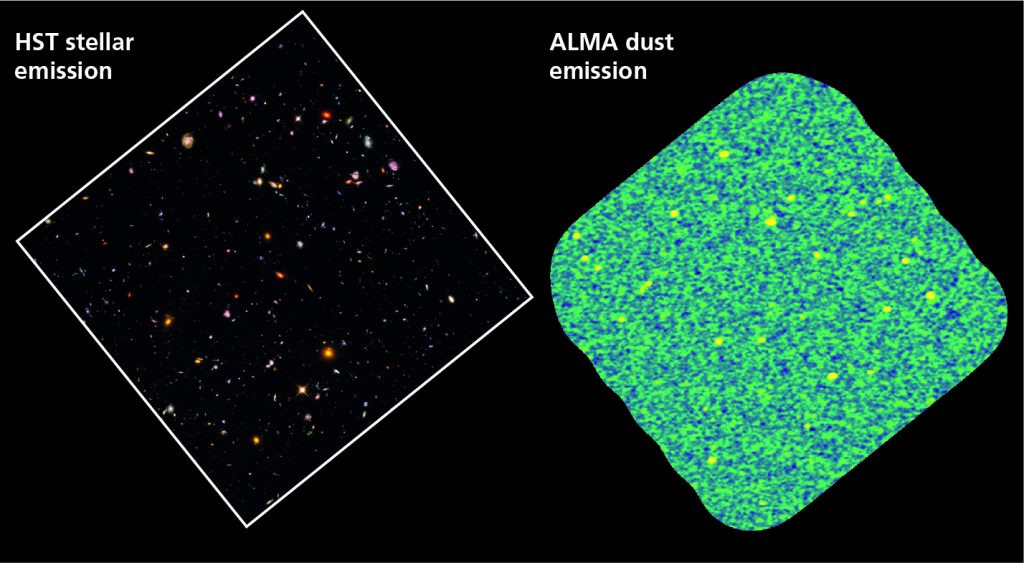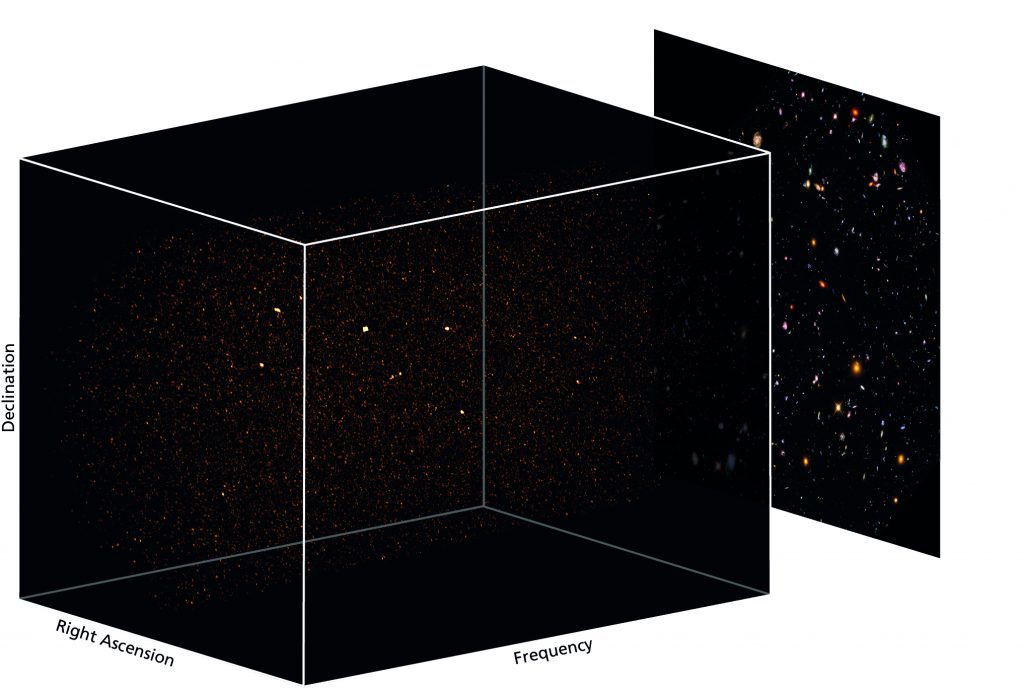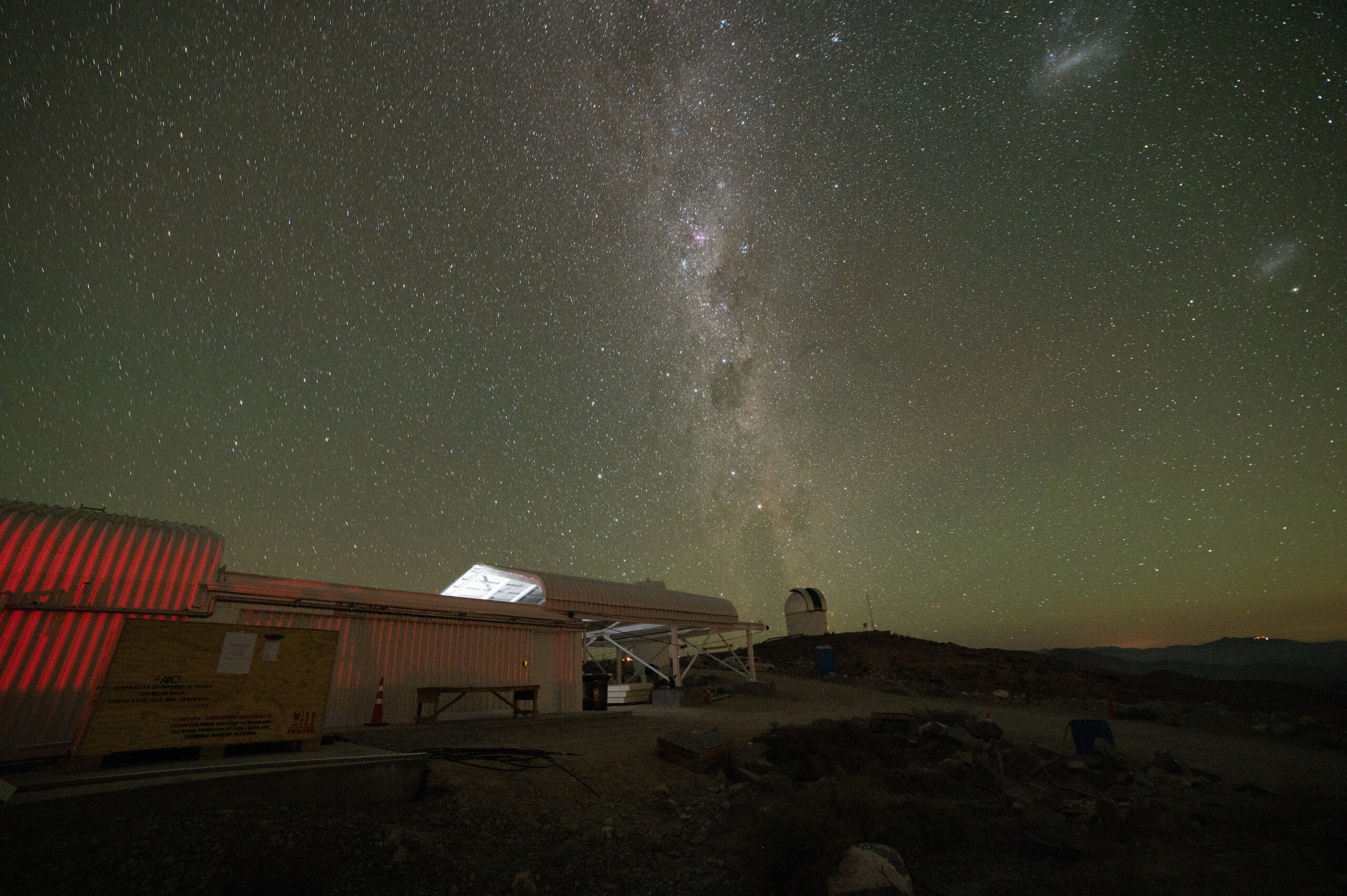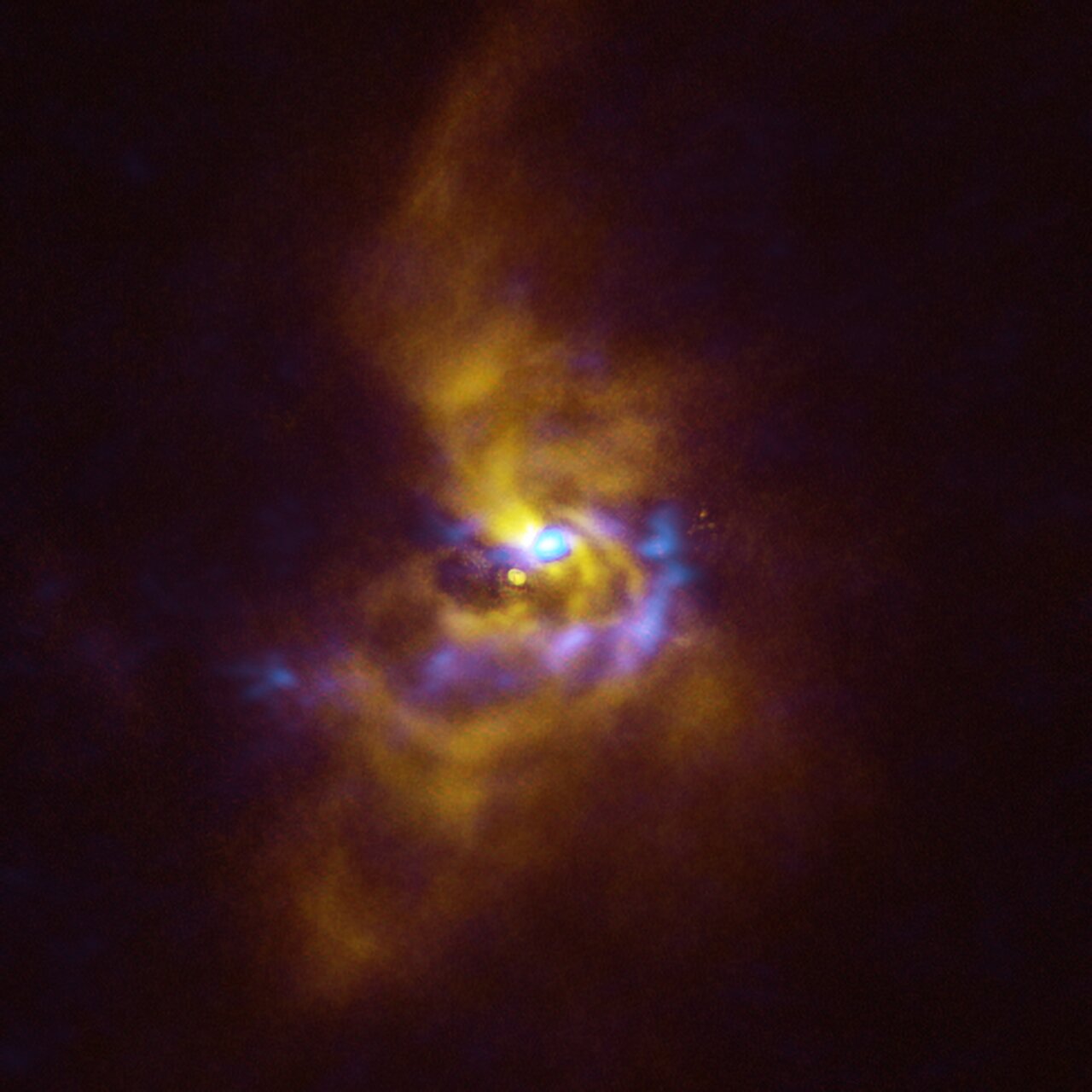
UDP astronomers obtain the deepest ALMA observations in the Hubble UDF
An international group of astronomers has used the ALMA observatory to obtain an inventory of molecular gas and dust in distant galaxies at unprecedented depth in the iconic Hubble Ultra-Deep Field (H-UDF), one of the best-studied regions of the sky. The final results are being presented in a series of papers in today’s Astrophysical Journal. A significant part of these results is led by UDP researchers: Prof. Manuel Aravena (co-principal investigator), Dr. Jorge González-Lopez (Carnegie/UDP fellow), Prof. Roberto Assef and Dr. Tanio Diaz-Santos.
It has been well established that stars form from the gravitational collapse of dense clouds of molecular gas. To characterize galaxies’ evolution, a measurement of their molecular gas content and its evolution over cosmic time is indispensable. Such a measurement was one of the three prime directives driving the ALMA project from its conception. With this goal in mind, an international group of astronomers has led the ALMA large program ASPECS (The ALMA SPECtroscopic Survey in the Hubble Ultra-Deep Field): The first extragalactic large program approved by ALMA, designed to make an unbiased, three-dimensional survey of the molecular gas content of galaxies in the best-studied extragalactic deep field, the iconic Hubble Ultra-Deep-Field (H-UDF).
The ASPECS team chose the H-UDF as their target. It provides the ultimate observations in depth and resolution across the electromagnetic spectrum, extending beyond traditional continuum imaging, and is ideally situated for ALMA observations. As Dr. Chris Carilli of the National Radio Astronomy Observatory (NRAO) explains: “The success of ASPECS stems from two major advances: the unparalleled sensitivity of the ALMA observatory, and the unprecedented multi-wavelength database that is available for the Hubble Ultra-Deep Field, as manifested by more than 1000 hours of observations using the most advance astronomical facilities, in space and on ground”.
The ASPECS team further chose an observational approach commonly referred to as ‘frequency scanning’ to obtain an unbiased measurement of molecular gas in a well-defined cosmic volume. This approach was selected to maximize the cosmic volume for red-shifted Carbon Monoxide (CO) lines, a direct tracer of molecular gas, and to obtain millimeter continuum images of the HUDF at unprecedented depths. Dr. Jorge González-López of UDP explains this method in the following way: “The frequency scanning technique is similar to tuning to your favorite AM/FM radio network, you move along the dial until you reach a signal. For us, each of these ‘radio networks’ will be a line detection of molecular gas in a distant galaxy”. The validity of the observational approach for the ASPECS large program was demonstrated through several pilot programs, both with the IRAM Plateau de Bure Interferometer and ALMA observations in earlier cycles. The unprecedented depth of the ALMA millimeter frequency scans and continuum images revealed the presence of dozens of distant, dusty galaxies over the H-UDF region allowing the ASPECS team to address several outstanding questions about how galaxies form and grow.
Aside from just pinpointing the galaxies that contain most of the cold gas and dust reservoirs in the UDF, the wealth of multi-wavelength data available for the ASPECS/UDF field, which includes deep NASA/ESA Hubble Space Telescope imaging and ESO Very Large Telescope MUSE spectroscopy, enables a full characterization of the physical properties of the ASPECS-detected galaxies. Prof. Manuel Aravena from UDP concludes, “The ASPECS data provide our deepest look at the distant dusty universe to date and could recover all massive reservoirs of dust and gas in the H-UDF. Owing to our observing strategy, we could identify massive gas reservoirs in galaxies where we did not expect them given the low star formation rates and stellar masses”. Indeed, the unprecedented depth achieved by the ASPECS survey allowed the team to identify as individual galaxies almost all of the cold dust reservoirs existent out to early cosmic times in the H-UDF. The ALMA results could be well explained in the context of previous measurements through parallel modeling efforts by the ASPECS team. They also confirm that, on average, galaxies ~10 billion years ago were mostly made up of molecular gas rather than stars, compared to the opposite seen in galaxies today.
The ASPECS survey also allowed for determining the evolution of the cosmic molecular gas density from the current universe back in time to within 2 Gyr of the Big Bang. As Dr. Roberto Decarli of the National Institute of Astrophysics in Bologna, Italy, explains “Our analysis unambiguously showed that the molecular gas density peaks at when the universe was about 4 Gyr old, and then declines by almost an order of magnitude to the value measured in the local universe.” This behavior was suggested in previous molecular deep fields, including the ASPECS pilot program. Still, now the better statistics allowed the ASPECS team to firmly conclude that there is a rise and fall for the molecular gas density with cosmic time. This peak of molecular gas density corresponds to the one in the star formation history (`the epoch of galaxy assembly’).
This behavior was put in context with other key estimates of galaxy properties, particularly the evolution of cosmic density of atomic gas, the star formation rate, and the stellar mass buildup. Dr. Fabian Walter of the Max Planck Institute for Astronomy in Heidelberg, Germany, concludes: “Putting all the information together, we were able to determine the amount of gas that had to be accreted to the centers of galaxies over cosmic time, to account for the stars that are present in galaxies.” As such, these observations provide significant constraints for galaxy evolution models and simulations.
In the future, the ASPECS team hopes to continue their studies of gas-rich galaxies by using higher-resolution ALMA data and soon to be obtained observations using NASA’s James Webb Space Telescope (scheduled to be launched in late 2021).
This project is based on the ALMA Large Project ASPECS, which has resulted in 20 publications in international peer-reviewed journals (see the team webpage at http://www.aspecs.info). The latest set of papers is available on arXiv on September 24, 2020. All data used by the team are made publicly available to the astronomical community through a dedicated webpage hosted by the ALMA observatory.
The research is part of the project Cosmic_Gas that has received funding from the European Research Council (ERC) under the European Union’s Horizon 2020 research and innovation programme (Grant agreement No. 740246). This work was supported by the grant CONICYT + PCI + INSTITUTO MAX PLANCK DE ASTRONOMIA MPG190030
The Atacama Large Millimeter/submillimeter Array (ALMA), an international astronomy facility, is a partnership of ESO, the U.S. National Science Foundation (NSF) and the National Institutes of Natural Sciences (NINS) of Japan in cooperation with the Republic of Chile. ALMA is funded by ESO on behalf of its Member States, by NSF in cooperation with the National Research Council of Canada (NRC) and the National Science Council of Taiwan (NSC) and by NINS in cooperation with the Academia Sinica (AS) in Taiwan and the Korea Astronomy and Space Science Institute (KASI). ALMA construction and operations are led by ESO on behalf of its Member States; by the National Radio Astronomy Observatory (NRAO), managed by Associated Universities, Inc. (AUI), on behalf of North America; and by the National Astronomical Observatory of Japan (NAOJ) on behalf of East Asia. The Joint ALMA Observatory (JAO) provides the unified leadership and management of the construction, commissioning and operation of ALMA.

Figure 1. The Hubble Ultra Deep Field (UDF): The left image shows the Hubble Space Telescope (HST) image, based on the deepest HST observations ever obtained, in optical and near-infrared wavelengths. It shows the presence of 100s of galaxies at different cosmic loopback times. The right image shows the same region on the sky, but obtained through the ASPECS ALMA Large Program, showing the dust emission of the UDF galaxies, as traced through millimetre wavelengths. This ALMA image provides the deepest view of the dusty universe in a cosmological deep field to date.

Figure 2. ALMA 3D gas tomography: The ASPECS ALMA Large Program imaged the UDF using ALMA frequency scans to search for molecular gas emission (as traced through carbon monoxide spectral lines). The net result are 3D data cubes, the three axes being right ascension, declination and frequency, where frequency equates to the line-of-sight distance via the redshift. This figure shows a rendering of the ALMA data, in which the ‘islands’ in the volume correspond to molecular gas emission lines of distant galaxies.









